Sustainability of Conventional Cars
VerifiedAdded on 2023/04/21
|8
|1708
|453
AI Summary
This research paper explores the sustainability of conventional cars and the introduction of hybrid cars as an alternative. It discusses the advantages and disadvantages of electric vehicles and presents a research study conducted on the sustainability of conventional cars in the UK.
Contribute Materials
Your contribution can guide someone’s learning journey. Share your
documents today.

Interim Report Cover Page
Title of report
(How sustainable are conventional
cars)
1 | P a g e
Title of report
(How sustainable are conventional
cars)
1 | P a g e
Secure Best Marks with AI Grader
Need help grading? Try our AI Grader for instant feedback on your assignments.

Introduction
This research problem in this paper deals with
sustainability of conventional cars in U.K. Conventional
cars use diesel or gasoline for powering the internal
combustion engine. Conventional engine are prime mover
that uses burning fuel in the engine as well as the
combustion products serve as thermodynamic fluid.
There are almost 95% of the motor vehicles that mainly
depends on energy and oil that holds hostage of car travel
to the geopolitical issues as well as the changes in oil
prices (Burns, 2013). This research mainly deals with
sustainability of conventional cars that are used in daily
life. This research can help to learn the sustainability of
conventional cars and the way the cars can be made
sustainable by introducing new methods.
This paper aims at finding the sustainability of the
conventional cars and the newly introduced sustainable
cars alternative to the conventional cars. This paper
consists of a background research study of the chosen
topic with the research methodology that will be carried
out for conducting the research study. There is also a
detailed questionnaire consisting the question that are to
be asked in the interview.
The gasoline cars provide many disadvantage that affects
the environment, health, and dependency of fossil fuels,
oil politics and many more. So, to make the conventional
cars more sustainable, hybrid cars have been introduced
for making the cars sustainable. The car owners prefers to
choose electric vehicles which helps them to reduce the
2 | P a g e
This research problem in this paper deals with
sustainability of conventional cars in U.K. Conventional
cars use diesel or gasoline for powering the internal
combustion engine. Conventional engine are prime mover
that uses burning fuel in the engine as well as the
combustion products serve as thermodynamic fluid.
There are almost 95% of the motor vehicles that mainly
depends on energy and oil that holds hostage of car travel
to the geopolitical issues as well as the changes in oil
prices (Burns, 2013). This research mainly deals with
sustainability of conventional cars that are used in daily
life. This research can help to learn the sustainability of
conventional cars and the way the cars can be made
sustainable by introducing new methods.
This paper aims at finding the sustainability of the
conventional cars and the newly introduced sustainable
cars alternative to the conventional cars. This paper
consists of a background research study of the chosen
topic with the research methodology that will be carried
out for conducting the research study. There is also a
detailed questionnaire consisting the question that are to
be asked in the interview.
The gasoline cars provide many disadvantage that affects
the environment, health, and dependency of fossil fuels,
oil politics and many more. So, to make the conventional
cars more sustainable, hybrid cars have been introduced
for making the cars sustainable. The car owners prefers to
choose electric vehicles which helps them to reduce the
2 | P a g e
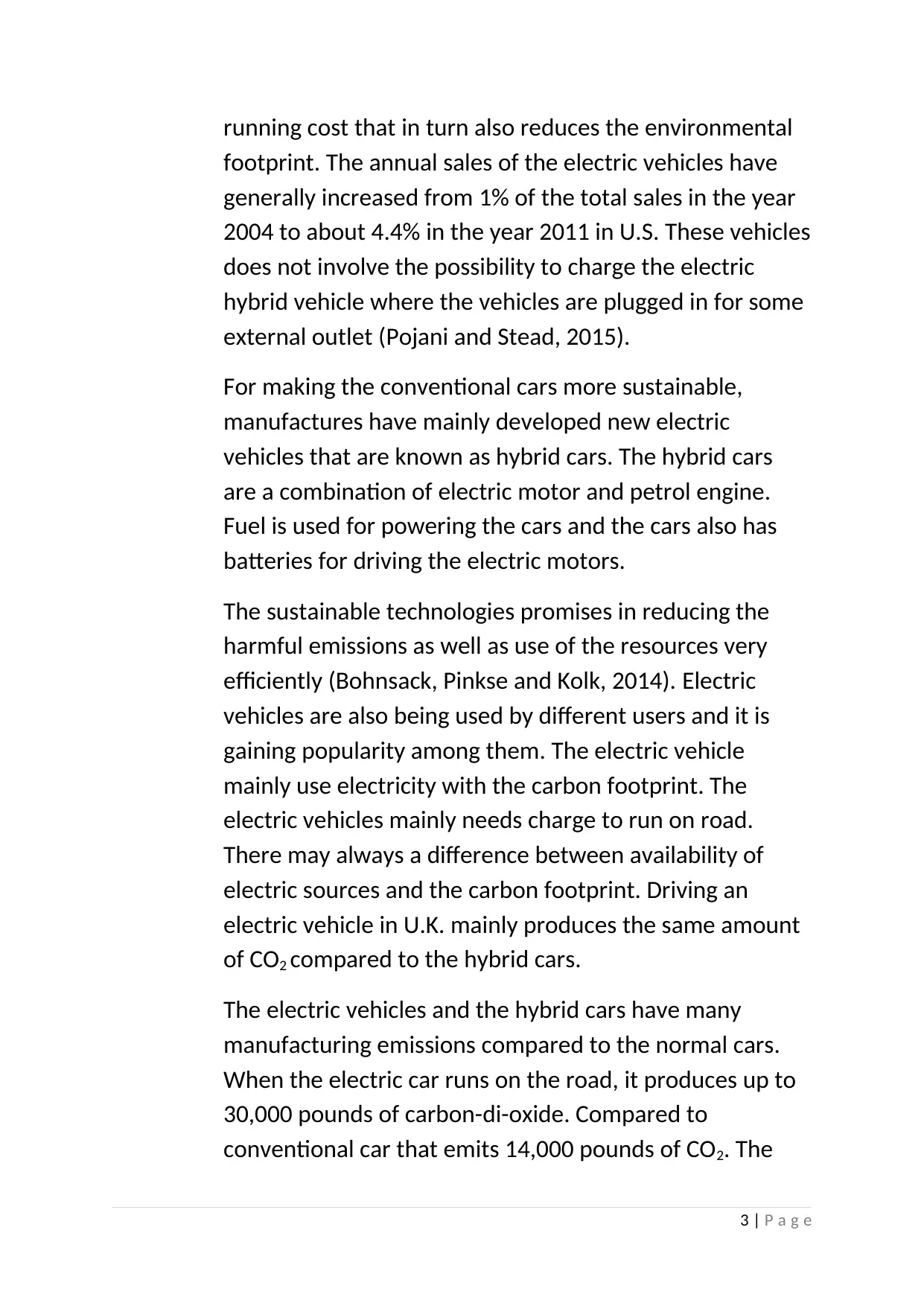
running cost that in turn also reduces the environmental
footprint. The annual sales of the electric vehicles have
generally increased from 1% of the total sales in the year
2004 to about 4.4% in the year 2011 in U.S. These vehicles
does not involve the possibility to charge the electric
hybrid vehicle where the vehicles are plugged in for some
external outlet (Pojani and Stead, 2015).
For making the conventional cars more sustainable,
manufactures have mainly developed new electric
vehicles that are known as hybrid cars. The hybrid cars
are a combination of electric motor and petrol engine.
Fuel is used for powering the cars and the cars also has
batteries for driving the electric motors.
The sustainable technologies promises in reducing the
harmful emissions as well as use of the resources very
efficiently (Bohnsack, Pinkse and Kolk, 2014). Electric
vehicles are also being used by different users and it is
gaining popularity among them. The electric vehicle
mainly use electricity with the carbon footprint. The
electric vehicles mainly needs charge to run on road.
There may always a difference between availability of
electric sources and the carbon footprint. Driving an
electric vehicle in U.K. mainly produces the same amount
of CO2 compared to the hybrid cars.
The electric vehicles and the hybrid cars have many
manufacturing emissions compared to the normal cars.
When the electric car runs on the road, it produces up to
30,000 pounds of carbon-di-oxide. Compared to
conventional car that emits 14,000 pounds of CO2. The
3 | P a g e
footprint. The annual sales of the electric vehicles have
generally increased from 1% of the total sales in the year
2004 to about 4.4% in the year 2011 in U.S. These vehicles
does not involve the possibility to charge the electric
hybrid vehicle where the vehicles are plugged in for some
external outlet (Pojani and Stead, 2015).
For making the conventional cars more sustainable,
manufactures have mainly developed new electric
vehicles that are known as hybrid cars. The hybrid cars
are a combination of electric motor and petrol engine.
Fuel is used for powering the cars and the cars also has
batteries for driving the electric motors.
The sustainable technologies promises in reducing the
harmful emissions as well as use of the resources very
efficiently (Bohnsack, Pinkse and Kolk, 2014). Electric
vehicles are also being used by different users and it is
gaining popularity among them. The electric vehicle
mainly use electricity with the carbon footprint. The
electric vehicles mainly needs charge to run on road.
There may always a difference between availability of
electric sources and the carbon footprint. Driving an
electric vehicle in U.K. mainly produces the same amount
of CO2 compared to the hybrid cars.
The electric vehicles and the hybrid cars have many
manufacturing emissions compared to the normal cars.
When the electric car runs on the road, it produces up to
30,000 pounds of carbon-di-oxide. Compared to
conventional car that emits 14,000 pounds of CO2. The
3 | P a g e
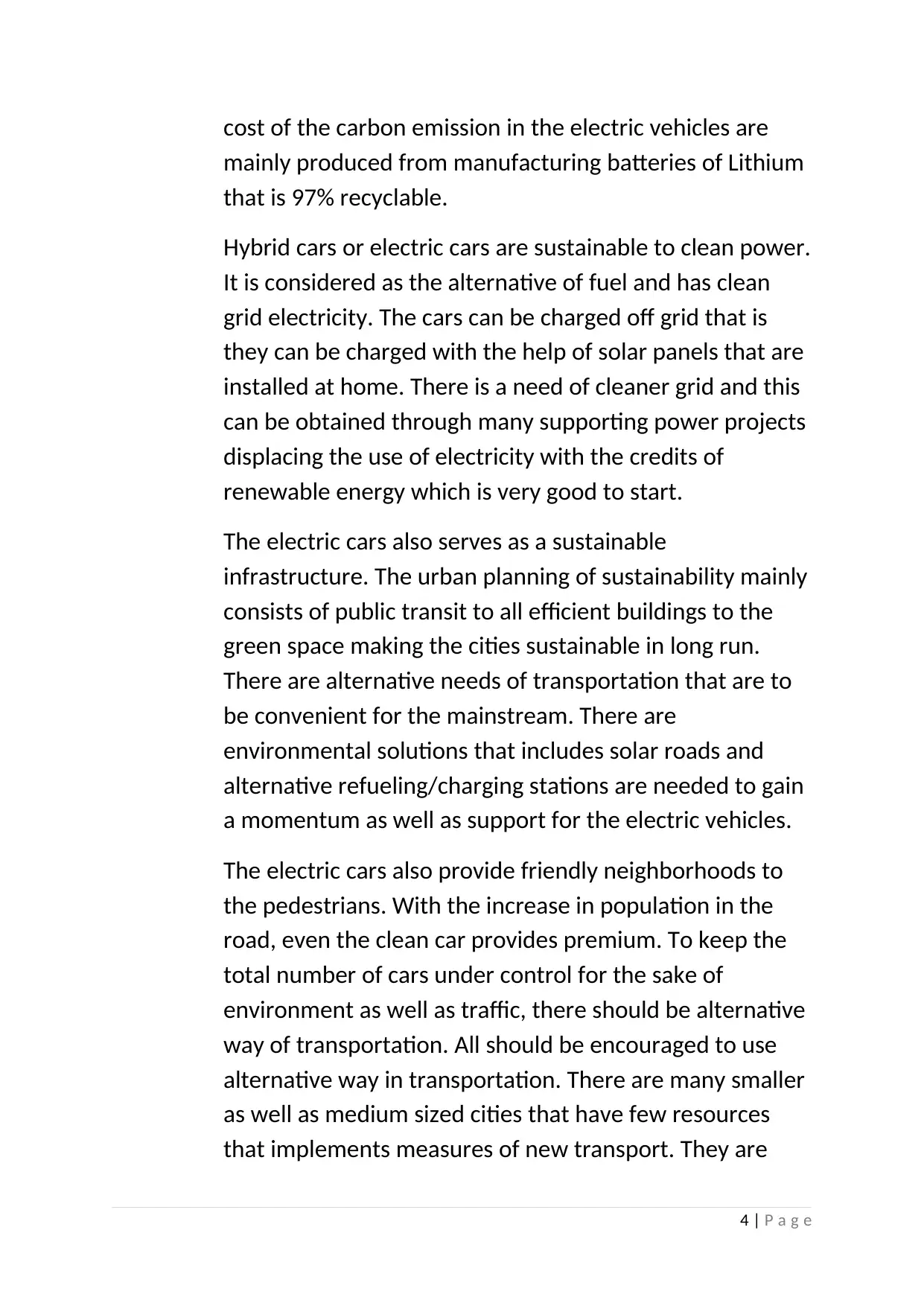
cost of the carbon emission in the electric vehicles are
mainly produced from manufacturing batteries of Lithium
that is 97% recyclable.
Hybrid cars or electric cars are sustainable to clean power.
It is considered as the alternative of fuel and has clean
grid electricity. The cars can be charged off grid that is
they can be charged with the help of solar panels that are
installed at home. There is a need of cleaner grid and this
can be obtained through many supporting power projects
displacing the use of electricity with the credits of
renewable energy which is very good to start.
The electric cars also serves as a sustainable
infrastructure. The urban planning of sustainability mainly
consists of public transit to all efficient buildings to the
green space making the cities sustainable in long run.
There are alternative needs of transportation that are to
be convenient for the mainstream. There are
environmental solutions that includes solar roads and
alternative refueling/charging stations are needed to gain
a momentum as well as support for the electric vehicles.
The electric cars also provide friendly neighborhoods to
the pedestrians. With the increase in population in the
road, even the clean car provides premium. To keep the
total number of cars under control for the sake of
environment as well as traffic, there should be alternative
way of transportation. All should be encouraged to use
alternative way in transportation. There are many smaller
as well as medium sized cities that have few resources
that implements measures of new transport. They are
4 | P a g e
mainly produced from manufacturing batteries of Lithium
that is 97% recyclable.
Hybrid cars or electric cars are sustainable to clean power.
It is considered as the alternative of fuel and has clean
grid electricity. The cars can be charged off grid that is
they can be charged with the help of solar panels that are
installed at home. There is a need of cleaner grid and this
can be obtained through many supporting power projects
displacing the use of electricity with the credits of
renewable energy which is very good to start.
The electric cars also serves as a sustainable
infrastructure. The urban planning of sustainability mainly
consists of public transit to all efficient buildings to the
green space making the cities sustainable in long run.
There are alternative needs of transportation that are to
be convenient for the mainstream. There are
environmental solutions that includes solar roads and
alternative refueling/charging stations are needed to gain
a momentum as well as support for the electric vehicles.
The electric cars also provide friendly neighborhoods to
the pedestrians. With the increase in population in the
road, even the clean car provides premium. To keep the
total number of cars under control for the sake of
environment as well as traffic, there should be alternative
way of transportation. All should be encouraged to use
alternative way in transportation. There are many smaller
as well as medium sized cities that have few resources
that implements measures of new transport. They are
4 | P a g e
Secure Best Marks with AI Grader
Need help grading? Try our AI Grader for instant feedback on your assignments.
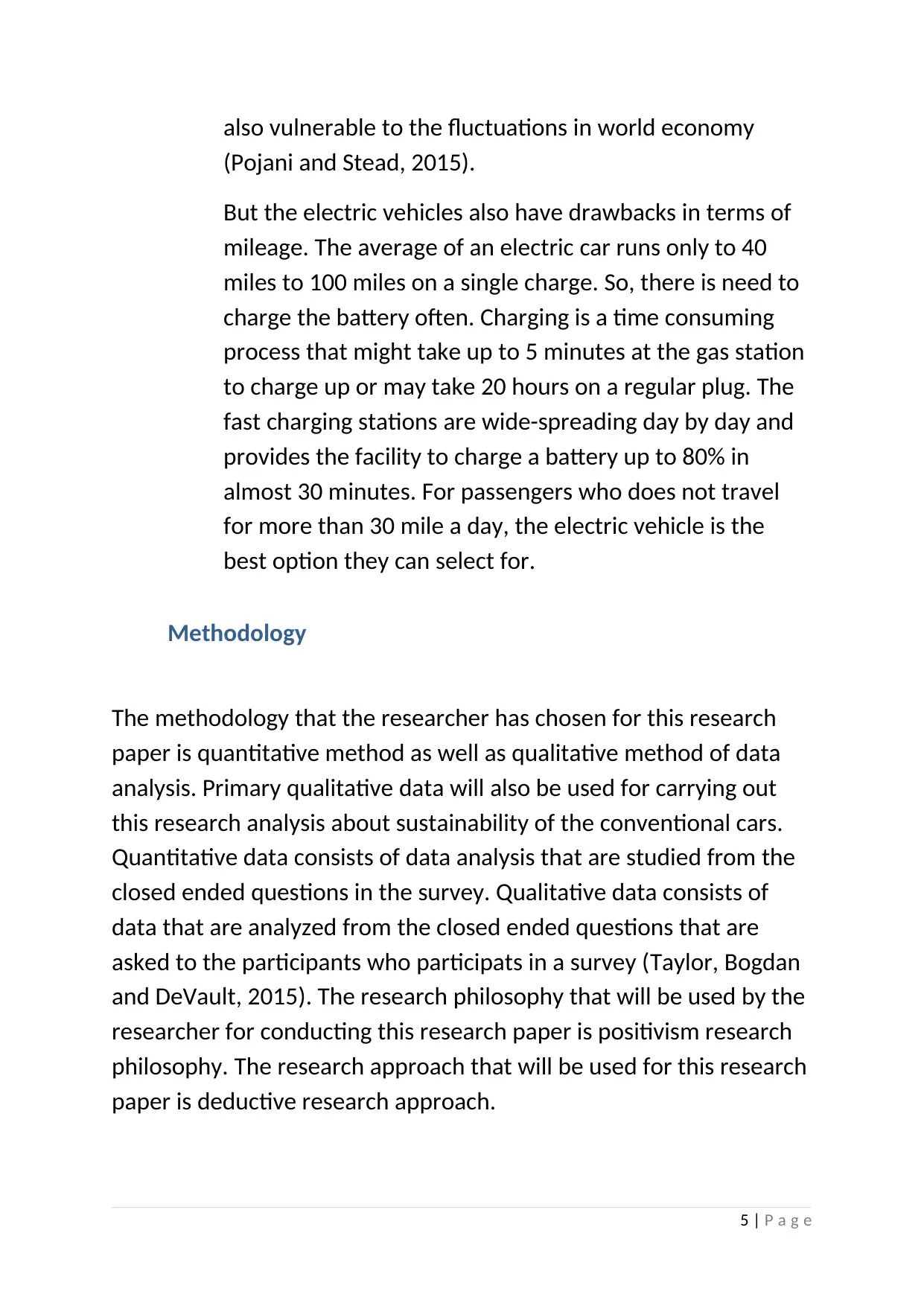
also vulnerable to the fluctuations in world economy
(Pojani and Stead, 2015).
But the electric vehicles also have drawbacks in terms of
mileage. The average of an electric car runs only to 40
miles to 100 miles on a single charge. So, there is need to
charge the battery often. Charging is a time consuming
process that might take up to 5 minutes at the gas station
to charge up or may take 20 hours on a regular plug. The
fast charging stations are wide-spreading day by day and
provides the facility to charge a battery up to 80% in
almost 30 minutes. For passengers who does not travel
for more than 30 mile a day, the electric vehicle is the
best option they can select for.
Methodology
The methodology that the researcher has chosen for this research
paper is quantitative method as well as qualitative method of data
analysis. Primary qualitative data will also be used for carrying out
this research analysis about sustainability of the conventional cars.
Quantitative data consists of data analysis that are studied from the
closed ended questions in the survey. Qualitative data consists of
data that are analyzed from the closed ended questions that are
asked to the participants who participats in a survey (Taylor, Bogdan
and DeVault, 2015). The research philosophy that will be used by the
researcher for conducting this research paper is positivism research
philosophy. The research approach that will be used for this research
paper is deductive research approach.
5 | P a g e
(Pojani and Stead, 2015).
But the electric vehicles also have drawbacks in terms of
mileage. The average of an electric car runs only to 40
miles to 100 miles on a single charge. So, there is need to
charge the battery often. Charging is a time consuming
process that might take up to 5 minutes at the gas station
to charge up or may take 20 hours on a regular plug. The
fast charging stations are wide-spreading day by day and
provides the facility to charge a battery up to 80% in
almost 30 minutes. For passengers who does not travel
for more than 30 mile a day, the electric vehicle is the
best option they can select for.
Methodology
The methodology that the researcher has chosen for this research
paper is quantitative method as well as qualitative method of data
analysis. Primary qualitative data will also be used for carrying out
this research analysis about sustainability of the conventional cars.
Quantitative data consists of data analysis that are studied from the
closed ended questions in the survey. Qualitative data consists of
data that are analyzed from the closed ended questions that are
asked to the participants who participats in a survey (Taylor, Bogdan
and DeVault, 2015). The research philosophy that will be used by the
researcher for conducting this research paper is positivism research
philosophy. The research approach that will be used for this research
paper is deductive research approach.
5 | P a g e
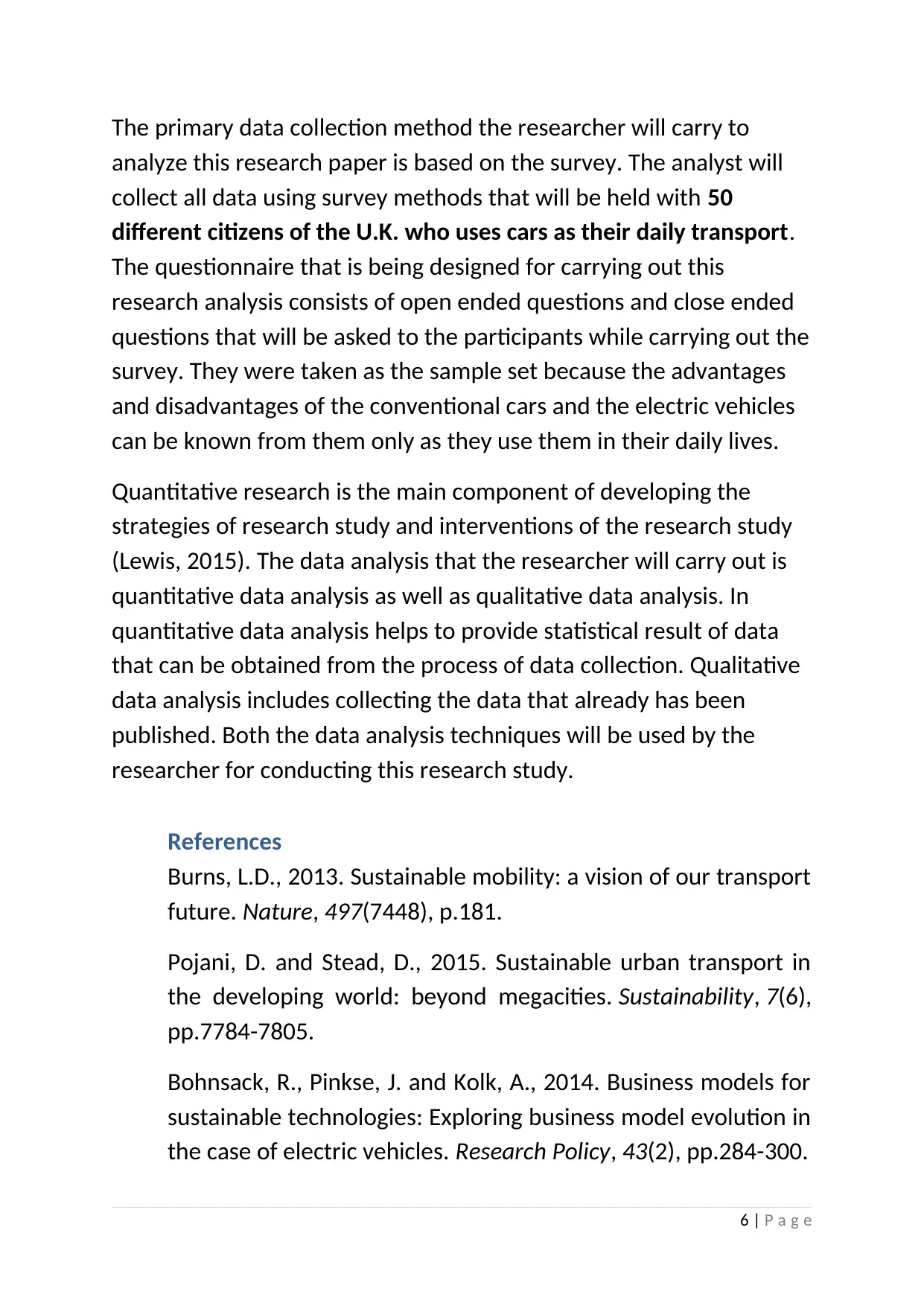
The primary data collection method the researcher will carry to
analyze this research paper is based on the survey. The analyst will
collect all data using survey methods that will be held with 50
different citizens of the U.K. who uses cars as their daily transport.
The questionnaire that is being designed for carrying out this
research analysis consists of open ended questions and close ended
questions that will be asked to the participants while carrying out the
survey. They were taken as the sample set because the advantages
and disadvantages of the conventional cars and the electric vehicles
can be known from them only as they use them in their daily lives.
Quantitative research is the main component of developing the
strategies of research study and interventions of the research study
(Lewis, 2015). The data analysis that the researcher will carry out is
quantitative data analysis as well as qualitative data analysis. In
quantitative data analysis helps to provide statistical result of data
that can be obtained from the process of data collection. Qualitative
data analysis includes collecting the data that already has been
published. Both the data analysis techniques will be used by the
researcher for conducting this research study.
References
Burns, L.D., 2013. Sustainable mobility: a vision of our transport
future. Nature, 497(7448), p.181.
Pojani, D. and Stead, D., 2015. Sustainable urban transport in
the developing world: beyond megacities. Sustainability, 7(6),
pp.7784-7805.
Bohnsack, R., Pinkse, J. and Kolk, A., 2014. Business models for
sustainable technologies: Exploring business model evolution in
the case of electric vehicles. Research Policy, 43(2), pp.284-300.
6 | P a g e
analyze this research paper is based on the survey. The analyst will
collect all data using survey methods that will be held with 50
different citizens of the U.K. who uses cars as their daily transport.
The questionnaire that is being designed for carrying out this
research analysis consists of open ended questions and close ended
questions that will be asked to the participants while carrying out the
survey. They were taken as the sample set because the advantages
and disadvantages of the conventional cars and the electric vehicles
can be known from them only as they use them in their daily lives.
Quantitative research is the main component of developing the
strategies of research study and interventions of the research study
(Lewis, 2015). The data analysis that the researcher will carry out is
quantitative data analysis as well as qualitative data analysis. In
quantitative data analysis helps to provide statistical result of data
that can be obtained from the process of data collection. Qualitative
data analysis includes collecting the data that already has been
published. Both the data analysis techniques will be used by the
researcher for conducting this research study.
References
Burns, L.D., 2013. Sustainable mobility: a vision of our transport
future. Nature, 497(7448), p.181.
Pojani, D. and Stead, D., 2015. Sustainable urban transport in
the developing world: beyond megacities. Sustainability, 7(6),
pp.7784-7805.
Bohnsack, R., Pinkse, J. and Kolk, A., 2014. Business models for
sustainable technologies: Exploring business model evolution in
the case of electric vehicles. Research Policy, 43(2), pp.284-300.
6 | P a g e
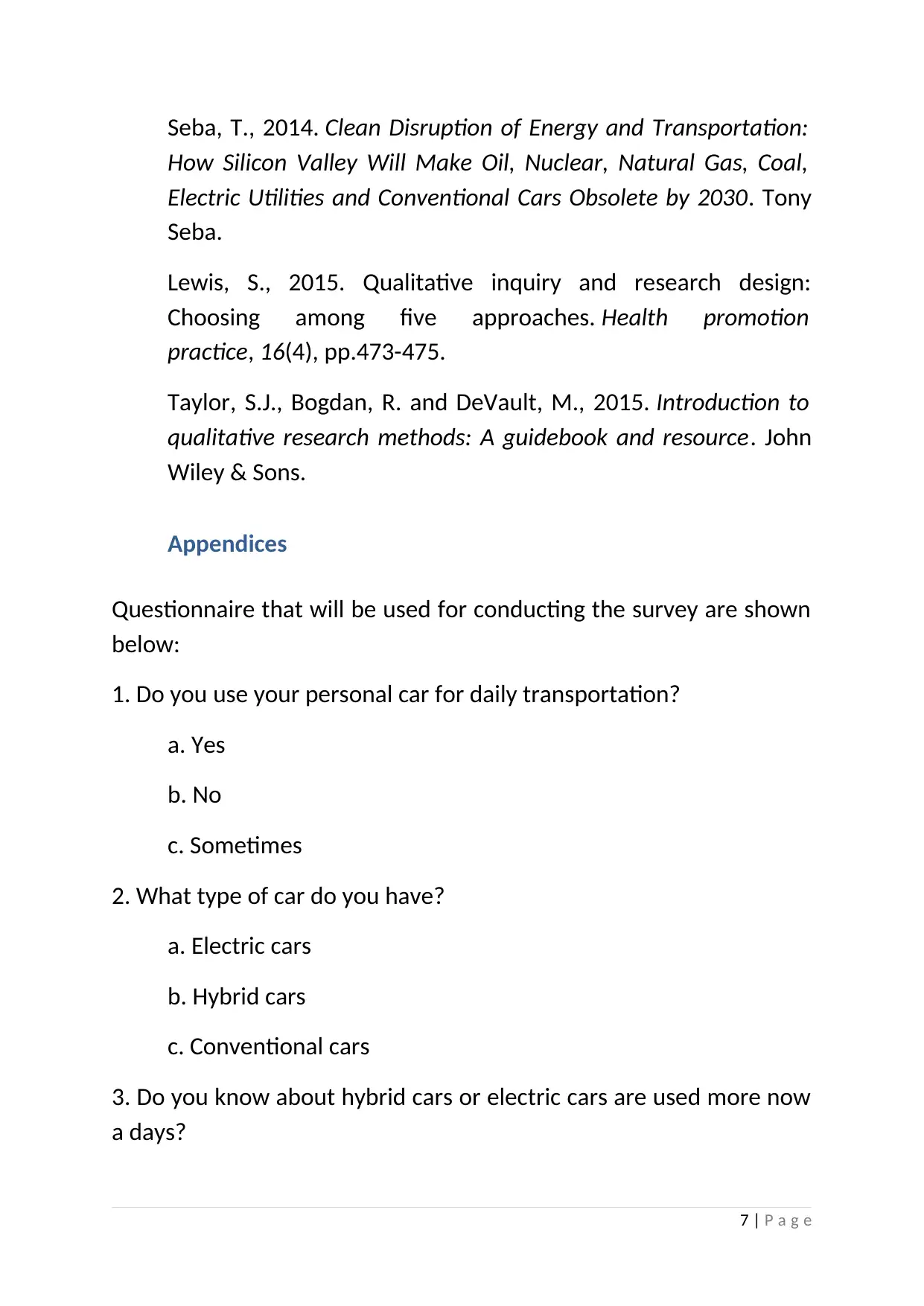
Seba, T., 2014. Clean Disruption of Energy and Transportation:
How Silicon Valley Will Make Oil, Nuclear, Natural Gas, Coal,
Electric Utilities and Conventional Cars Obsolete by 2030. Tony
Seba.
Lewis, S., 2015. Qualitative inquiry and research design:
Choosing among five approaches. Health promotion
practice, 16(4), pp.473-475.
Taylor, S.J., Bogdan, R. and DeVault, M., 2015. Introduction to
qualitative research methods: A guidebook and resource. John
Wiley & Sons.
Appendices
Questionnaire that will be used for conducting the survey are shown
below:
1. Do you use your personal car for daily transportation?
a. Yes
b. No
c. Sometimes
2. What type of car do you have?
a. Electric cars
b. Hybrid cars
c. Conventional cars
3. Do you know about hybrid cars or electric cars are used more now
a days?
7 | P a g e
How Silicon Valley Will Make Oil, Nuclear, Natural Gas, Coal,
Electric Utilities and Conventional Cars Obsolete by 2030. Tony
Seba.
Lewis, S., 2015. Qualitative inquiry and research design:
Choosing among five approaches. Health promotion
practice, 16(4), pp.473-475.
Taylor, S.J., Bogdan, R. and DeVault, M., 2015. Introduction to
qualitative research methods: A guidebook and resource. John
Wiley & Sons.
Appendices
Questionnaire that will be used for conducting the survey are shown
below:
1. Do you use your personal car for daily transportation?
a. Yes
b. No
c. Sometimes
2. What type of car do you have?
a. Electric cars
b. Hybrid cars
c. Conventional cars
3. Do you know about hybrid cars or electric cars are used more now
a days?
7 | P a g e
Paraphrase This Document
Need a fresh take? Get an instant paraphrase of this document with our AI Paraphraser
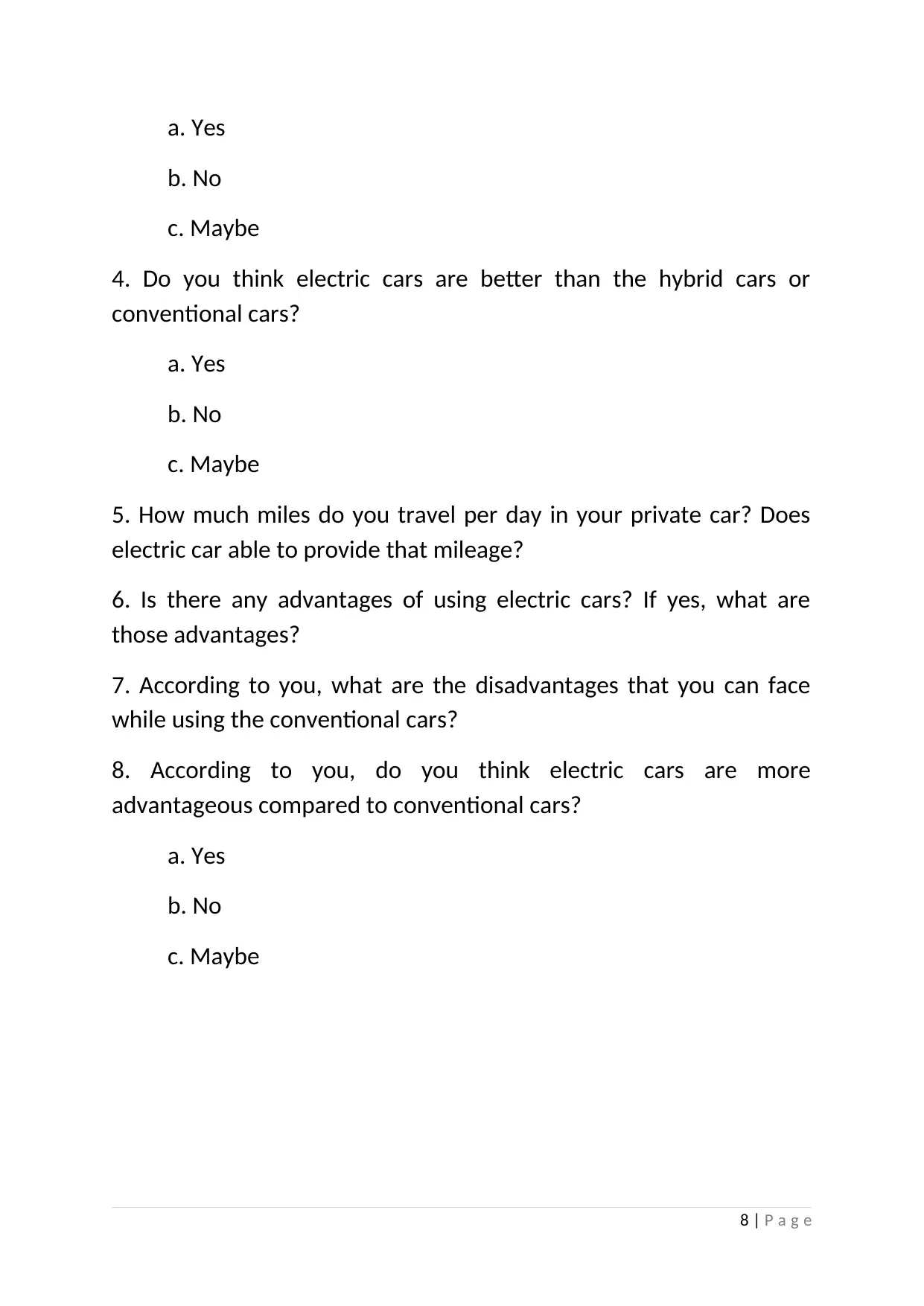
a. Yes
b. No
c. Maybe
4. Do you think electric cars are better than the hybrid cars or
conventional cars?
a. Yes
b. No
c. Maybe
5. How much miles do you travel per day in your private car? Does
electric car able to provide that mileage?
6. Is there any advantages of using electric cars? If yes, what are
those advantages?
7. According to you, what are the disadvantages that you can face
while using the conventional cars?
8. According to you, do you think electric cars are more
advantageous compared to conventional cars?
a. Yes
b. No
c. Maybe
8 | P a g e
b. No
c. Maybe
4. Do you think electric cars are better than the hybrid cars or
conventional cars?
a. Yes
b. No
c. Maybe
5. How much miles do you travel per day in your private car? Does
electric car able to provide that mileage?
6. Is there any advantages of using electric cars? If yes, what are
those advantages?
7. According to you, what are the disadvantages that you can face
while using the conventional cars?
8. According to you, do you think electric cars are more
advantageous compared to conventional cars?
a. Yes
b. No
c. Maybe
8 | P a g e
1 out of 8
Related Documents
Your All-in-One AI-Powered Toolkit for Academic Success.
+13062052269
info@desklib.com
Available 24*7 on WhatsApp / Email
![[object Object]](/_next/static/media/star-bottom.7253800d.svg)
Unlock your academic potential
© 2024 | Zucol Services PVT LTD | All rights reserved.


![Hybrid and Electric Vehicles: Battery Power Report - [University Name]](/_next/image/?url=https%3A%2F%2Fdesklib.com%2Fmedia%2Fimages%2Foz%2Fe29569c874f844d2874f09f043debbd5.jpg&w=256&q=75)


